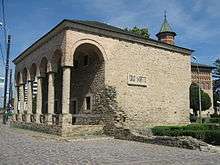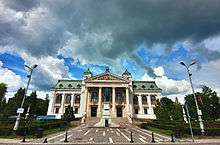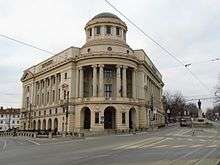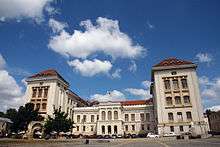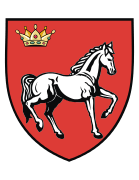Iași
Iași (UK: /ˈjæʃi/ YASH-ee, US: /ˈjɑːʃ(i)/ YAHSH(-ee), Romanian: [ˈjaʃʲ] (![]()
Iași Jassy | |
|---|---|
County Seat | |
.jpg) From top left: Palace of Culture, Vasile Alecsandri Statue in front of the National Theatre, Alexandru Ioan Cuza University, Golia Tower, Metropolitan Cathedral, and the Botanical Garden | |
 Coat of arms | |
| Nickname(s): | |
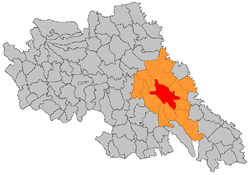 Location of Iași and its metropolitan area in Iași County | |
 Iași Location in Romania | |
| Coordinates: 47°09′25″N 27°35′25″E | |
| Country | |
| County | |
| Status | Municipiu |
| Settled | Before 14th century |
| First official record | 1408 |
| Government | |
| • Mayor | Mihai Chirica[5] (National Liberal Party) |
| Area | |
| • County Seat | 93.9 km2 (36.3 sq mi) |
| • Metro | 808 km2 (312 sq mi) |
| Elevation | 60 m (200 ft) |
| Population (2011 census)[6] | |
| • County Seat | 290,422 |
| • Estimate (2018)[7] | 378,954 |
| • Density | 3,092/km2 (8,010/sq mi) |
| • Metro | 500,668[7] |
| Time zone | UTC+2 (EET) |
| • Summer (DST) | UTC+3 (EEST) |
| Postal Code | 700xxx |
| Area code(s) | +40 x32 |
| Car Plates | IS |
| Climate | Dfb |
| Website | www |
Known as The Cultural Capital of Romania, Iași is a symbol in Romanian history. The historian Nicolae Iorga said "There should be no Romanian who does not know of it".[11] Still referred to as The Moldavian Capital, Iași is the main economic and business centre of the Moldavian region of Romania.[12] In December 2018, Iași was officially declared Historical capital of Romania.[13]
At the 2011 census, the city proper had a population of 290,422 (making it the fourth most populous in Romania at the time). With 500,668 residents (as of 2018), the Iași urban area is the second most populous in Romania (after Bucharest),[7] whereas more than 500,000 people live within its peri-urban area.[6][14]
Home to the oldest Romanian university and to the first engineering school, Iași is one of the most important education and research centres of the country, and accommodates over 60,000 students in 5 public universities.[15][16] The social and cultural life revolves around the Vasile Alecsandri National Theater (the oldest in Romania), the Moldova State Philharmonic, the Opera House, the Iași Athenaeum, a famous Botanical Garden (the oldest and largest in Romania), the Central University Library (the oldest in Romania), the high quality cultural centres and festivals, an array of museums, memorial houses, religious and historical monuments. The city is also known as the site of the largest Romanian pilgrimage which takes place each year, in October.[17]
Etymology and names
- Arabic: ياشي/اياشي/ياسي ("Yassy/Iashy/Yashy")
- Bulgarian: Яш (Yash)
- English: Jassy
- French: Iassy
- German: Jassy, Jassenmarkt, Jasmarkt
- Greek: Ιάσιο (Iásio)
- Hebrew: יאסי (Iasi) or יאשי (iaši).
- Hungarian: Jászvásár
- Italian: Iassi
- Persian: Yās
- Polish: Jassy
- Russian: Яссы (Yassy)
- Serbian: Јаши or Jaši
- Turkish: Yaş
- Ukrainian: Ясси, Яси - also, Я́сси, Я́си (Yassy, Yasy)
- Yiddish: יאס (Yas)
Scholars have different theories on the origin of the name "Iași".[18] Some argue that the name originates with the Sarmatian tribe Iazyges (of Iranian origin), one mentioned by Ovid as Latin: "Ipse vides onerata ferox ut ducata Iasyx/ Per media Histri plaustra bubulcus aquas" and "Iazyges et Colchi Metereaque turba Getaque/ Danubii mediis vix prohibentur aquis".[19]
A now lost inscription on a Roman milestone[20] found near Osijek, Croatia by Matija Petar Katančić in the 18th century, mentions the existence of a Jassiorum municipium,[21] or Municipium Dacorum-Iassiorum from other sources.[22]
Other explanations show that the name originated from the Iranian Alanic tribe of Jassi, having same origin with Yazyges tribes Jassic people. In medieval times the Prut river was known as Alanus fluvius and the city as Forum Philistinorum.[23][24][25] From this population derived the plural of town name, "Iașii".
Another historian wrote that the Iasians lived among the Cumans and that they left the Caucasus after the first Mongolian campaign in the West, settling temporarily near the Prut. He asserts that the ethnic name of Jasz which is given to Iasians by Hungarians has been erroneously identified with the Jazyges; also he shows that the word jasz is a Slavic loan word.[26] The Hungarian name of the city (Jászvásár) literally means "Jassic Market"; the antiquated Romanian name, Târgul Ieșilor (and the once-favoured Iașii), and the German Jassenmarkt, may indicate the same meaning.
History
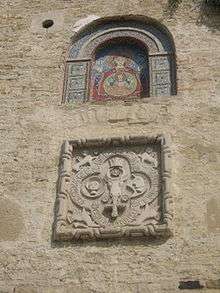
Ancient times
Archaeological investigations attest to the presence of human communities on the present territory of the city and around it as far back as the prehistoric age.[22] Later settlements included those of the Cucuteni–Trypillia culture, a late Neolithic archaeological culture.
There is archaeological evidence of human settlements in the area of Iași dating from the 6th to 7th centuries (Curtea Domnească) and 7th to 10th centuries; these settlements contained rectangular houses with semicircular ovens.[27] Also, many of the vessels (9th–11th centuries) found in Iași had a cross, potentially indicating that the inhabitants were Christians.[28]
Early development
The name of the city is first found in a document from 1408. This is a grant of certain commercial privileges by the Moldavian Prince Alexander to the Polish merchants of Lvov. However, as buildings older than 1408 still exist, e.g. the Armenian Church believed to be originally built in 1395, it is certain that the city existed before its first surviving written mention.
Capital of Moldavia
Around 1564, Prince Alexandru Lăpușneanu moved the Moldavian capital from Suceava to Iași. Between 1561 and 1563, a school and a Lutheran church were founded by the Greek adventurer Prince, Ioan Iacob Heraclid.
.jpg)
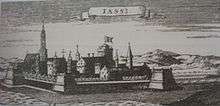

In 1640, Vasile Lupu established the first school in which the Romanian language replaced Greek, and set up a printing press in the Byzantine Trei Ierarhi Monastery (Monastery of the Three Hierarchs; built 1635–39). Between 15 September - 27 October 1642, the city hosted the Synod of Jassy (also referred to as the Council of Jassy). In 1643, the first volume ever printed in Moldavia was published in Iași.
The city was burned down by the Tatars in 1513, by the Ottomans in 1538, and by Imperial Russian troops in 1686. In 1734, it was hit by the plague.
It was through the Peace of Iași that the sixth Russo-Turkish War was brought to a close in 1792. A Greek revolutionary manoeuvre and occupation under Alexander Ypsilanti (Αλέξανδρος Υψηλάντης) and the Filiki Eteria (Φιλική Εταιρία) (1821, at the beginning of the Greek War of Independence) led to the storming of the city by the Turks in 1822. In 1844 a severe fire affected much of the city.
Mid–19th century to 20th century
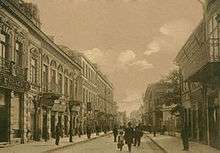
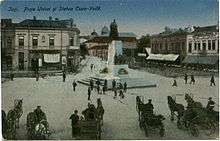
Between 1564 and 1859, the city was the capital of Moldavia; then, between 1859 and 1862, both Iași and Bucharest were de facto capitals of the United Principalities of Moldavia and Wallachia. In 1862, when the union of the two principalities was recognised under the name of Romania, the national capital was established in Bucharest. For the loss caused to the city in 1861 by the removal of the seat of government to Bucharest the constituent assembly voted 148,150 lei to be paid in ten annual instalments, but no payment was ever made.
During World War I, Iași was the capital of a much reduced Romania for two years, following the Central Powers' occupation of Bucharest on 6 December 1916. The capital was returned to Bucharest after the defeat of Imperial Germany and its allies in November 1918. In November–December 1918 Iași hosted the Jassy Conference.
Jewish community
Iași also figures prominently in Jewish history, with the first documented presence of Sephardi Jews from the late 16th century. The oldest tomb inscription in the local cemetery probably dates to 1610.[29] By the mid-19th century, owing to widespread Russian Jewish and Galician Jewish immigration into Moldavia, the city was at least one-third Jewish.
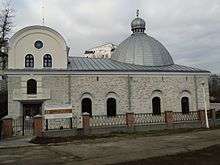
In 1855, Iași was the home of the first-ever Yiddish-language newspaper, Korot Haitim, and, in 1876, the site of what was arguably the first-ever professional Yiddish theatre performance, established by Avraham Goldfaden. The words of HaTikvah, the national anthem of Israel, were written in Iași by Naftali Herz Imber. Jewish musicians in Iași played an important role as preservers of Yiddish folklore, as performers and composers.
According to the 1930 census, with a population of 34,662 (some 34% of the city's population), Jews were the second largest ethnic group in Iași. There were over 127 synagogues. After World War II, in 1947, there were about 38,000 Jews living in Iași. Because of massive emigration to Israel, in 1975 there were about 3,000 Jews living in Iași and four synagogues were active.[29]
Currently, Iași has a dwindling Jewish population of ca. 300 to 600 members and two working synagogues, one of which, the 1671 Great Synagogue, is the oldest surviving synagogue in Romania.[30]
World War II
During the war, while the full scale of the Holocaust remained generally unknown to the Allied Powers, the Iași pogrom stood as one of the known examples of Axis brutality toward the Jews. The pogrom lasted from 29 June to 6 July 1941, and over 13,266 people,[31] or one third of the Jewish population, were massacred in the pogrom itself or in its aftermath, and many were deported.
In May 1944, the Iași area became the scene of ferocious fighting between Romanian-German forces and the advancing Soviet Red Army and the city was partially destroyed. The German Panzergrenadier Division Großdeutschland won a defensive victory at the Battle of Târgu Frumos, near Iași, which was the object of several NATO studies during the Cold War. By 20 August, Iași had been taken by Soviet forces.[32]
Post-World War II era
Iași experienced a major wave of industrialisation, in 1955–1989.[33] During this period of time, it received numerous migrants from rural regions, and the urban area expanded.[34] In the communist era, Iași saw a growth of 235% in population and 69% in area. The local systematization plans of the old city started in 1960 and continued in the 1970s and 1980s as part of the larger national systematization program; however, the urban planning was sometimes arbitrary and followed by dysfunctions.[35] By 1989, Iași had become highly industrialised, with 108,000 employees (representing 47% of the total workforce) active in 46 large state-owned enterprises, in various industries: machine building and heavy equipment, chemical, textile, pharmaceutical, metallurgical, electronics, food, energy, building materials, furniture.[36][37]
After the end of communist rule and the transition to a free market economy, the private sector has grown steadily, while much of the old industry gradually decayed.
Geography
Topography
Located in the North-East of Romania, at the contact between the Jijia Plain and the Bârlad Plateau, Iași used to be the crossroads place of the historic trade routes that passed through Moldavia coming from the Kingdom of Poland, Habsburg Monarchy, Tsardom of Russia, and Constantinople.
The city lies on the Bahlui River valley, a tributary of the Jijia River (tributary of the Prut River). The surrounding country is one of uplands and woods, featuring monasteries and parks. Iași itself stands amid vineyards and gardens, partly on hills, partly in the in-between valley.
The central part of the city is located on the 25 m (82 ft) fluvial terrace of the Bahlui River (the so-called Palat Terrace).[38] From this nucleus, the city evolved after the medieval times toward south and north on the Bahlui River floodplain and on the adjacent hills. The southern part of the city lies on the Iași Ridge (Romanian: Coasta Iașilor) (the northern-most hill of the Bârlad Plateau). Considering the present day extension of the administrative boundaries, the city territory has an altitudinal extension of 320 m (1,050 ft), between the 34.5 m a.s.l. (113.19 ft) in the Bahlui River floodplain, at the Holboca bridge, and 354.77 m a.s.l. (1,163.94 ft), at the edge of the Repedea Hill.
It is a common belief that Iași is built on seven hills (Romanian: coline): Breazu, Bucium, Cetățuia, Copou, Galata, Repedea and Șorogari, thus triggering comparisons with Rome.
Climate
| Climate data for Iași, Romania (1981–2010) | |||||||||||||
|---|---|---|---|---|---|---|---|---|---|---|---|---|---|
| Month | Jan | Feb | Mar | Apr | May | Jun | Jul | Aug | Sep | Oct | Nov | Dec | Year |
| Record high °C (°F) | 16.7 (62.1) |
22.5 (72.5) |
27.0 (80.6) |
31.8 (89.2) |
36.4 (97.5) |
38.0 (100.4) |
40.1 (104.2) |
39.7 (103.5) |
38.0 (100.4) |
33.9 (93.0) |
29.0 (84.2) |
19.5 (67.1) |
40.1 (104.2) |
| Average high °C (°F) | 1.1 (34.0) |
3.3 (37.9) |
9.3 (48.7) |
16.7 (62.1) |
23.1 (73.6) |
26.1 (79.0) |
28.1 (82.6) |
27.8 (82.0) |
22.4 (72.3) |
16.1 (61.0) |
8.1 (46.6) |
2.3 (36.1) |
15.4 (59.7) |
| Daily mean °C (°F) | −2.3 (27.9) |
−0.9 (30.4) |
3.9 (39.0) |
10.5 (50.9) |
16.7 (62.1) |
19.9 (67.8) |
21.7 (71.1) |
20.9 (69.6) |
15.9 (60.6) |
10.2 (50.4) |
4.0 (39.2) |
−0.9 (30.4) |
10.0 (50.0) |
| Average low °C (°F) | −5.2 (22.6) |
−4.2 (24.4) |
−0.1 (31.8) |
5.4 (41.7) |
10.6 (51.1) |
14.2 (57.6) |
15.9 (60.6) |
15.2 (59.4) |
10.8 (51.4) |
5.9 (42.6) |
0.9 (33.6) |
−3.7 (25.3) |
5.5 (41.9) |
| Record low °C (°F) | −30.6 (−23.1) |
−36.3 (−33.3) |
−22.7 (−8.9) |
−9.4 (15.1) |
−3.0 (26.6) |
3.5 (38.3) |
6.3 (43.3) |
4.6 (40.3) |
−3.5 (25.7) |
−9.6 (14.7) |
−21.1 (−6.0) |
−29.5 (−21.1) |
−36.3 (−33.3) |
| Average precipitation mm (inches) | 27.9 (1.10) |
25.9 (1.02) |
30.8 (1.21) |
46.1 (1.81) |
55.2 (2.17) |
88.2 (3.47) |
74.9 (2.95) |
54.9 (2.16) |
54.9 (2.16) |
37.0 (1.46) |
34.3 (1.35) |
31.6 (1.24) |
561.7 (22.11) |
| Average snowfall cm (inches) | 11.3 (4.4) |
14.3 (5.6) |
11.9 (4.7) |
6.9 (2.7) |
0.0 (0.0) |
0.0 (0.0) |
0.0 (0.0) |
0.0 (0.0) |
0.0 (0.0) |
0.7 (0.3) |
10.4 (4.1) |
6.3 (2.5) |
61.8 (24.3) |
| Average precipitation days (≥ 0.1 mm) | 12.6 | 11.2 | 11.6 | 11.4 | 12.1 | 12.3 | 11.0 | 8.5 | 8.7 | 8.1 | 10.1 | 12.6 | 130.2 |
| Average relative humidity (%) | 82 | 80 | 71 | 62 | 61 | 62 | 60 | 63 | 66 | 73 | 79 | 83 | 70 |
| Mean monthly sunshine hours | 67 | 91 | 136 | 180 | 256 | 260 | 288 | 275 | 200 | 153 | 79 | 61 | 2,046 |
| Source 1: World Meteorological Organization,[39] Ogimet (mean temperatures and sun 1981–2010)[40] | |||||||||||||
| Source 2: Romanian National Statistic Institute (extremes 1901–2000),[41] NOAA (sunshine and snowfall 1961–1990),[42] Deutscher Wetterdienst (extremes, 1896–2015 and humidity, 1896–1960)[43] | |||||||||||||
Iași has a humid, continental-type climate (Köppen climate classification "Dfb" — summer wetter than winter, European subtype) with four distinct seasons. Summers are warm with temperatures sometimes exceeding 35 °C (95 °F) while winters are cold and windy with moderate snowfall and temperatures at night sometimes dropping below −15 °C (5 °F). Average monthly precipitation ranges from about 25 mm (1.0 in) in October to 100 mm (3.9 in)in June.
Cityscape
Architecture
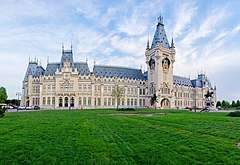
Iași features historical monuments, 500-year-old churches and monasteries, contemporary architecture, many of them listed on the National Register of Historic Monuments. Notable architecture includes the Trei Ierarhi Monastery, part of the tentative list of UNESCO World Heritage Site, or the neo-Gothic Palace of Culture, built on the old ruins of the mediaeval Princely Court of Moldavia.
During World War II and the Communist era many historical buildings in the old city centre (around Union Square area) were destroyed or demolished, and replaced by International style buildings and also a new mainly Mid-Century modern style Civic Centre was built around the Old Market Square (The Central Hall).[33]
The mid-1990s to early-2000s brought the first non-industrial glass curtain walled buildings (Romtelecom, Hotel Europa), while in 2012, in close proximity to the Palace of Culture, the Palas shopping mall and office complex was inaugurated.
Other significant buildings include:
- Alexandru Ioan Cuza University main building (1897), a mixture of the Neoclassical and Baroque styles, houses the famous Hall of the Lost Footsteps where one can admire the works of the painter Sabin Bălașa;
- "Vasile Alecsandri" National Theatre, built between 1894 and 1896 in Neoclassic style with Baroque and Rococo inspired painted and sculpted ornaments;
- Dosoftei House, a building from the second half of the 17th century in which in 1679, the metropolitan bishop Dosoftei settled the second typography in Moldavia. With three façades, arched and right-angled windows, the edifice was restored between 1966 and 1969. It houses the department of old literature of the Romanian Literature Museum;
- Roznovanu Palace (The City Hall), second half of the 18th century, rebuilt between 1830 and 1833, it hosted the Romanian government during World War I;
- Union Museum, 1806, Empire style, the palace served as the royal residence of Prince Alexandru Ioan Cuza between 1859 and 1862 and in 1917–1918, during World War I, as the royal residence of king Ferdinand;
- Pogor House, 1850, a meeting place for the city intellectuals, the headquarters of Literary Society Junimea (1863) and of the Convorbiri Literare (Literary Interlocutions) magazine (1867), houses the Romanian Literature Museum;
- Luceafărul Theatre, 1987, a unique modern building in Romania;
- Central University Library, 1934, incorporates Greek Revival elements;
- Great Railway Station, 1870, inspired by Venetian Doge's Palace.
Religious buildings
Iași is the seat of the Romanian Orthodox Metropolitan of Moldavia and Bukovina, and of the Roman Catholic Bishop of Iași. The city and the surrounding area house more than 10 monasteries and 100 historical churches.[44] Among the oldest is Princely Saint Nicholas (1491), dating from the reign of Stephen the Great, and the Metropolitan Cathedral is the largest of its kind in Romania. The Trei Ierarhi Monastery, a unique monument, considered to be an architectural masterpiece,[45] was erected in 1635–1639 by Vasile Lupu, and adorned with gilded carvings on its outer walls and twin towers.
- Metropolitan Cathedral (1839/1886), the largest Orthodox church in Romania, a late Renaissance style, with Baroque elements and Gheorghe Tattarescu paintings, it contains the relics of Saint Paracheva (sometimes known colloquially in English as Saint Friday);[44]
- Golia Monastery, 1564, rebuilt in 1650 in late-Renaissance style with Byzantine frescoes and intricately carved doorways, is a monumental construction, a monastery in the middle of the city, surrounded by tall walls, with corner turrets, and a 30 m (98.43 ft) height bell tower;
- Old Catholic Cathedral, 1782, in Baroque style, and New Catholic Cathedral, 2005;
- Armenian Church, built in 1395, testifies the existence of an important Armenian community in these parts of Romania;
- Great Synagogue, in late Baroque style, built in 1657–1671, is the oldest surviving synagogue in Romania and one of the oldest in Europe.[44]
Other examples of historic churches and monasteries (some of them surrounded by defence walls and towers) include: Socola (1562), Galata (1582), Saint Sava (1583), Hlincea (1587), Aroneanu (1594), Bârnova (1603), Barnovschi (1627), Golia (1650), Cetățuia (1668), Frumoasa (1726), Saint Spiridon (1747), Old Metropolitan Cathedral (1761), Bărboi (1843 with 18th-century bell tower), Bucium (1853).[46]
- Barnovschi Church
- Golia Church architectural elements
 Moldavian princely palace at Cetățuia Monastery
Moldavian princely palace at Cetățuia Monastery St. George Church (Old Metropolitan Cathedral)
St. George Church (Old Metropolitan Cathedral)
Pilgrimage
The city has become a major Christian pilgrimage site since the early modern period. In 1641, the relics of Saint Parascheva were brought to Iași. Each year, around 14 October, hundreds of thousands of pilgrims gather to commemorate Saint Parascheva, while the city itself established its Celebration Days at the same time.[47] The October pilgrimage is one of the largest in Europe, drawing people all over Romania as well as from neighboring Orthodox countries.[17]
During the entire year, pilgrimages to Iași can also involve visits to a large number of religious sites, both within and around the city.
Gardens, parks and natural landmarks
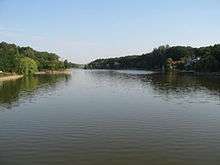
Iași has a diverse array of public spaces, from city squares to public parks.
Begun in 1833, at the time when Iași was the capital of Moldavia, by Prince Mihail Sturdza and under the plans of Gheorghe Asachi and Mihail Singurov, Copou Park was integrated into the city and marks one of the first Romanian coordinated public parks. The oldest monument in Romania stands in the middle of the park, the Obelisk of Lions (1834), a 13.5 m (44.29 ft) tall obelisk, dedicated to the Regulamentul Organic, the first law on political, administrative and juridical organisation in Romanian Principalities.[48]
Founded in 1856, the Botanical Garden of Iași, the first botanical garden in Romania, has an area of over 100 hectares, and more than 10,000 species of plants.
Iași Exhibition Park was opened in 1923 and built under the co-ordination of the architect N. Ghica Budești.
The Ciric Park, located in the north-eastern part of Iași, consists of parkland and four lakes.
Eminescu's Linden Tree (Romanian: Teiul lui Eminescu) is a 500-year-old silver lime (Tilia tomentosa Moench) situated in Copou Park. Mihai Eminescu reportedly wrote some of his best works underneath this lime, rendering the tree one of Romania's most important natural monuments and a notable Iași landmark.[49] The Odd Poplers Alley, in Bucium neighbourhood, is another spot where Mihai Eminescu sought inspiration (the poem "Down Where the Lonely Poplars Grow"). In 1973, the 15 white poplars still left (with the age ranges between 233 and 371 years) were declared natural monuments.
Iași County has 387 centuries-old trees, of which 224 were declared monument trees and 160 got the Romanian Academy's approval and are proposed for such a classification. Most of them are oak or linden trees. The oldest tree in the county is the 675-year-old hybrid lime tree located in the courtyard of Bârnova Monastery, in the vicinity of Iași. When the lime was about 57 years old and about 14 cm (5.5 in) in diameter, Iași was mentioned as an urban settlement, during the reign of Prince Alexander the Good (1408).[50]
Demographics
| Year | Pop. | ±% |
|---|---|---|
| 18th century | 30,000 | — |
| 1831 | 59,880 | +99.6% |
| 1851 | 70,000 | +16.9% |
| 1859 | 65,745 | −6.1% |
| 1900 | 78,067 | +18.7% |
| 1912 | 75,229 | −3.6% |
| 1930 | 102,872 | +36.7% |
| 1941 | 111,669 | +8.6% |
| 1948 | 94,075 | −15.8% |
| 1956 | 112,977 | +20.1% |
| 1966 | 161,023 | +42.5% |
| 1977 | 265,002 | +64.6% |
| 1992 | 344,425 | +30.0% |
| 2002 | 320,888 | −6.8% |
| 2011 | 290,422 | −9.5% |
| Sources: 18th century, 1831, 1859,[51] 1851,[52] 1900,[53] 1912 Census,[54] 1930, 1956–2011: Censuses, 1941, 1948.[55] | ||
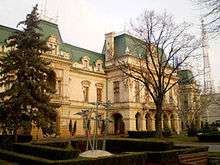
As of 1 January 2016, Iași is the country's second most populous city after Bucharest with 378,954 residents registered within the city limits,[7] and with a population of 500,668 residents, the Iași urban area is also the second largest in Romania.[7]
At the 2011 census, Iași was the fourth most populous Romanian city with a population of 290,422.[6] The metropolitan area association (which includes Iași and 13 other nearby communities) had a population of 382,484, while Iași County, with its 772,348 inhabitants, was the most populous county in Romania (after the Municipality of Bucharest). Additionally there were 60,000 more residents (mostly students) and thousands of daily commuters.
According to the 2002 census, in Iași there were 109,357 housing units and 320,888 people living within the city proper. Of this population, 98.5% were ethnic Romanians, while 0.59% were ethnic Romani, 0.13% Jews, 0.13% Greeks, 0.13% Lipovans, 0.08% Hungarians, 0.05% Germans and 0.39% others.[56] In terms of religion, 92.5% of the population were Christian Orthodox, 4.9% Roman Catholic, other religious groups 2.6%. There are currently almost 10,000 Roman Catholics living in Iași.[57] There is a debate between historians as to whether the Catholics are originally of Romanian or Hungarian descent.[58]
Economy
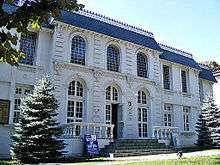
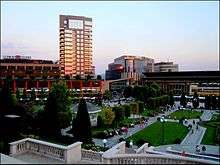
Iași is an important economic centre in Romania. The local and regional economy relies on industry and service sector institutions and establishments. The most important service sectors are related to education, health care, banking, research, culture, government and tourism.
The city is an important information technology sector centre, with the presence of several large multinational companies (Amazon, Oracle, Continental, Xerox, Accenture, Capgemini) and many other local and foreign companies such as Bentley Systems, Bitdefender, Comodo, Endava, Ness, Pentalog, SCC or TiVo (to name a few),[59] as well as two universities which offer specific degree programs. Industry forecasts expect the Iași ITC workforce to grow from the current 16,000 (end of 2016) employees to more than 33,000, by 2030.[60]
An estimated workforce of more than 35,000 employees is active in Iași's industrial manufacturing sector,[61] particularly in automotive (Delphi, Lear, Tess Conex), pharmaceutical industry (Antibiotice Iași, Fiterman Pharma, Ircon SRL), metallurgical production (ArcelorMittal, Technosteel LBR), aerospace (BMT Aerospace), industrial equipment (Agmus, ASAM, Fortus), energy (E.ON Moldova Distribuție, Veolia Energie), textiles and clothing (Benetton, Iași Conf, Iașitex), home appliances (Tehnoton), building materials (Brikston, Build Corp), food (Compan, Panifcom, Zeelandia).[37][62]
Located in an area recognised for its vineyards and wines, Iași is part of a traditional wine region with viticultural centres surrounding the city: Copou, Bucium, Uricani, Comarna, Plugari, and Probota. Iași County is also home to renowned Cotnari and Bohotin vineyards.[63][64]
With large shopping malls and commercial centres located in the area, Iași also has a well-developed retail business.
Largest employers
| Company | Industry | Employees |
|---|---|---|
| Sf. Spiridon University Hospital | Health care | 2,944 |
| Alexandru Ioan Cuza University | High education | 2,021 |
| Conduent | IT services | 1,876 |
| Delphi Diesel Systems | Automotive industry | 1,724 |
| Gheorghe Asachi Technical University | High education | 1,710 |
| Continental Automotive Romania | Automotive Engineering | 1,600 |
| Antibiotice Iași | Pharmaceutical industry | 1,458 |
| RATP | Public transport | 1,349 |
| St. Maria Clinic Children's Hospital | Health care | 1,256 |
| University of Medicine and Pharmacy | High Education | 1,230 |
Politics and administration
The city's current local council has the following multi-party political composition, based on the results of the ballots cast at the 2016 Romanian local elections:
| Party | Seats | Current Council | ||||||||||||||
|---|---|---|---|---|---|---|---|---|---|---|---|---|---|---|---|---|
| Social Democratic Party (PSD) | 14 | |||||||||||||||
| National Liberal Party (PNL) | 8 | |||||||||||||||
| Alliance of Liberals and Democrats (ALDE) | 2 | |||||||||||||||
| People's Movement Party (PMP) | 2 | |||||||||||||||
| Independent | 1 | |||||||||||||||
Culture
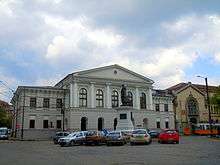
Major events in the political and cultural history of Moldavia are connected with the name of the city of Iași. The great scholars of the 17th century, Grigore Ureche, Miron Costin and later Ion Neculce, wrote most of their works in the city or not far from it and the famous scholar Dimitrie Cantemir known throughout all Europe also linked his name to the capital of Moldavia.
The first newspaper in Romanian language was published in 1829 in Iași and it is in Iași where, in 1867, appeared under literary society Junimea, the Convorbiri Literare review in which Ion Creangă’s Childhood Memories and the best poems by Mihai Eminescu were published. The reviews Contemporanul and Viața Românească appeared in 1871, respectively in 1906 with great contributions to promoting Romanian national cultural values.
Many great personalities of Romanian culture are connected to Iași: the chronicler Nicolae Milescu, the historians and politicians Mihail Kogălniceanu and Simion Bărnuțiu, the poets Vasile Alecsandri and George Topârceanu, the writers Mihail Sadoveanu, Alecu Russo, and Ionel Teodoreanu, the literary critic Titu Maiorescu, the historian A.D. Xenopol, the philosophers Vasile Conta and Petre Andrei, the sociologist Dimitrie Gusti, the geographer Emil Racoviță and the painter Octav Băncilă, only to name a few.
Theatres and orchestras
The Vasile Alecsandri National Theatre, opened in 1840, is the first National Theatre in Romania. The building, designed according to the plans of the Viennese architects Hermann Helmer and Ferdinand Fellner, was raised between 1894 and 1896, and also hosts, starting 1956, the Iași Romanian National Opera.
Iași is also home to:
- Moldova State Philharmonic Orchestra
- Luceafărul Theatre
- Iași Athenaeum (also known as Tătărași Athenaeum)
- Ludic Student Theatre
- Teatru Fix
Museums
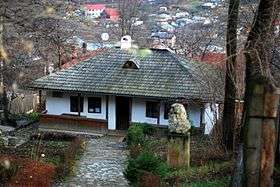
1.1.jpg)
Iași is home to many museums, memorial houses, art galleries.
First memorial museum from Romania opened in Iași in 1918, as the Ion Creangă Memorial House, and today the Iași Romanian Literature Museum owns fourteen memorial houses. The Mihai Eminescu Museum, situated in Copou Park, is dedicated to the great poet's life and creation; other museums are dedicated to: Dosoftei, Mihail Kogălniceanu, Vasile Pogor, Nicolae Gane, Petru Poni, Mihai Codreanu, Mihail Sadoveanu, George Topîrceanu, Otilia Cazimir, Radu Cernătescu, Cezar Petrescu, Dimitrie Anghel.
The Theatre Museum, opened in 1976, at the celebration of 160 years since the first theatrical performance in Romanian, illustrates the development of the theatrical phenomenon since the beginning, important moments of the history of Iași National Theatre, the foundation, in 1840, of the Philharmonic-dramatic Conservatoire, prestigious figures that have contributed to the development of the Romanian theatre.
The Union Museum, includes original pieces and documents which belonged to prince Al. I. Cuza and his family.
The Natural History Museum, founded on 4 February 1834, is the first museum of this kind in Romania with over 300,000 items, the most valuable being the collections of insects, mollusc, amphibians, reptiles, birds, plants and minerals.
Four other museums are located in the Palace of Culture: with its roots dating back to 1860, the Iași Art Museum is the oldest of its kind in Romania,[67] and, with more than 8,700 works (many of them belonging to the universal patrimony), has the largest art collection in the country; the Moldavia's History Museum, offers more than 48,000 objects from various fields, archaeology, numismatics, decorative art, ancient books, documents; the Ethnographic Museum of Moldavia owns more than 13,000 objects depicting the Romanian advance through the ages; the Science and Technology Museum's collection has more than 11,200 objects in five distinct sections and one memorial house.[68]
Foreign culture centres
Iași hosts six cultural centres: French, German, British, Latin American & Caribbean, Hellenic, and Arab.
Cultural events and festivals
- FILIT (International Festival of Literature and Translation) is a yearly literature and translation festival organised through the Iași Museum of Romanian Literature, begun in 2013;
- FIE (International Education Festival), launched in 2013, is a mix of cultural and educative events;
- International Theatre Festival for Young Audience was launched in 2008 and it is hosted each October by Luceafărul Theatre;
- Since 2010 at SFR(Romanian Film Nights) are presented films from different periods of Romanian cinema, as well as new films, debut films or short films, with the invitation of actors, directors, scriptwriters and film critics in the projection;
- Started in 2017, Afterhills is the biggest music festival in Moldavia. Other music festivals: Rock'n'Iași since 2007 and Rocanotherworld since 2016.
- Hangariada is an aeronautics and art festival organised each year in May;
Live music and different other artistic events (poetry nights, readings) are a habitual occurrence in the various bars and coffee shops the city has to offer.
Education
The first institute of higher learning that functioned on the territory of Romania was Academia Vasiliană (1640) founded by Prince Vasile Lupu as a "higher school for Latin and Slavonic languages", followed by the Princely Academy in 1707.
The first high education structure in Romanian language was established in the autumn of 1813, when engineer Gheorghe Asachi laid the foundations of a class of engineers, its activities taking place within the Greek Princely Academy.
After 1813, other moments marked the development of higher education in Romanian language, regarding both humanities and the technical science. In 1835, Academia Mihăileană founded by Prince Mihail Sturdza is considered first Romanian superior institute in the country.
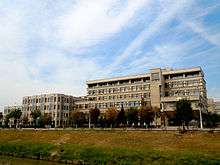
In 1860, three faculties part of the Academia Mihăileană formed the nucleus for the newly established University of Iași, the first Romanian university.
The Physicians and Naturalists Society, founded in Iași, has existed since the early part of the 19th century, and a number of periodicals are published. One of the oldest medical universities in Romania, founded in 1879, is located in Iași. It is now known as the Grigore T. Popa University of Medicine and Pharmacy.
In 1937, the two applied science sections of the University of Iași became departments of the newly created Gheorghe Asachi Polytechnic School. In the period before and after World War II, the later (renamed Polytechnic Institute in 1948) extended its domain of activity, especially in the field of engineering, and became known as Gheorghe Asachi Technical University in 1993.
Public universities include:
- Alexandru Ioan Cuza University- situated in Copou, is the oldest higher education institution in Romania;
- Gheorghe Asachi Technical University – the school with the oldest engineering tradition in Romania;
- Grigore T. Popa University of Medicine and Pharmacy – one of the oldest medicine schools in Romania;
- George Enescu National University of Arts – the oldest tradition in music and arts education in Romania;
- Ion Ionescu de la Brad University of Agricultural Sciences and Veterinary Medicine – one of the oldest schools of its kind.
There are also some private higher education institutions including Petre Andrei University, the largest private university in the historical region of Moldavia.[69]
The Central University Library of Iași, where the chief records of Romanian history are preserved, is the oldest and the second largest in Romania.
As of 2016, Iași has 74 public schools, coordinated by the Iași County School Inspectorate. The city is also home to 19 private schools.[70]
Notable high schools:
- Iași National College (1828)
- Costache Negruzzi National College (1895)
- Mihai Eminescu National College (1865)
- Vasile Lupu Pedagogical High School (1855)
- Emil Racoviță National College (1964)
Iași Science Festival is a week long festival organised every year in April (starting 2013) for high school and grade school students to get be able to observe and take part in scientific experiments and be given detailed tours of the scientific and technical universities and research labs in Iași. Over 200 experiments were performed and over 10,000 students took part in the 2014 edition, from throughout the Moldavia region.[71]
Media
Sports
In 2012, Iași was selected as one of the European Cities of Sport.[72]
Current teams

| Sport | League | Club | Founded | Venue |
|---|---|---|---|---|
| Basketball | Men's Divizia A | Politehnica Iași | Sala Polivalentă | |
| Basketball | Women's Divizia A | Politehnica Național Iași | Sala Polivalentă | |
| Football | Liga I | FC Politehnica Iași (2010) (as the informal successor to Politehnica Iași) | 16 August 2010 | Emil Alexandrescu Stadium |
| Handball | Women's Liga Națională | Terom Iași | Sala Polivalentă | |
| Rugby | SuperLiga | Poli Agro Unirea Iași | 1964 | Agronomia Stadium |
| Volleyball | Women's Divizia A2 | ACS Penicilina Iași | Sala Polivalentă |
Former teams
- FC Politehnica Iași of the Romanian Football League from 1945–2010.
Transport
Public transport
Iași's public transportation system is served by the CTP Iași which operates an extensive network using 126 trams (electric trams began operating in Iași in 1900) and 150 buses.[73] In 2014, the CTP (former RATP) carried 50,358,000 passengers, an average of 140,000 passengers per day.[74]
Air
Iași is served by the Iași International Airport (IAS) located 8 km (5.0 mi) east of the city centre. The airport is the 4th busiest in Romania and offers direct domestic, European, and Middle Eastern scheduled or charter connections. After extensive modernisation works, the number of connections and traffic volumes have seen a significant increase, in 2015.[75]
Rail
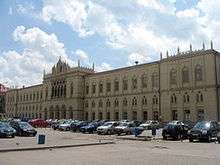
Iași-Pașcani railway was opened on 1 June [O.S. 20 May] 1870, Iași-Ungheni on 1 August 1874 and Iași-Chișinău railway was opened on 1 June 1875 by the Russian Empire in preparation for the Russo-Turkish War (1877–1878).
Nowadays, three railway stations, Great Railway Station, Nicolina International Rail Station and Socola Rail Station serve the city and are operated by Romanian Railways (CFR). Moldovan railway also serves these stations for travel into Moldova.
The Great Railway Station, located about 1 km (0.6 mi) from the city centre, provides direct rail connections to all the major Romanian cities and to Chișinău. The rail stations are very well connected to all the parts of the city by the trams and buses of the local public transport companies.
Road
Iași is connected by European routes E583/E85 with Bucharest through a four lane road, by European route E58 with Central Europe and Chișinău in Moldova, and by DN National Roads with all major cities of Romania. A planned East–West freeway would connect the city to the A3 Transylvania Motorway.
The Iași Coach Station is used by several private transport companies to provide coach connections from Iași to a large number of locations from all over the country.
Health care
Iași is home to 14 public hospitals, including the St. Spiridon Hospital, the second largest and one of the oldest in Romania (1755),[76] St. Maria Clinic Children's Hospital (one of the largest children's hospitals in the country), Institute of Cardiovascular Diseases, Regional Oncology Institute, and Socola Psychiatric Institute (1905 – first psychiatric hospital in Romania). The public system is complemented by numerous private clinics.
Air pollution concerns
Iași has the second-worse air quality in Romania, after Bucharest.[77] In 2014, the European Commission started environmental law infringement procedures against Romania, citing Bucharest, Iași, and Brașov cases as examples.[78] In 2015, atmospheric particulate matter has repeatedly reached and exceeded legal thresholds for PM10. Pollution from vehicular traffic, construction works, and a lack of green spaces (the city only has about 11 m2 (118 sq ft) of public green spaces per capita) make up some of the reasons behind these problems.[77]
Monuments and history
 Stephen the Great
Stephen the Great

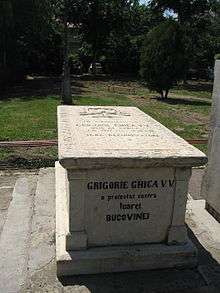 Grigore III Ghica Monument
Grigore III Ghica Monument
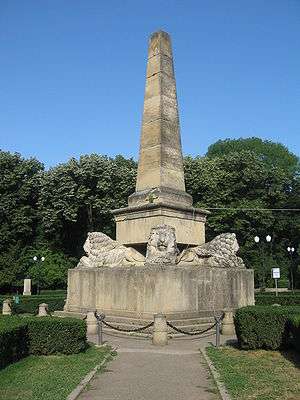


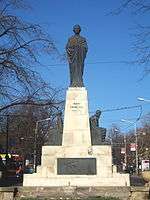

 Independence Monument
Independence Monument
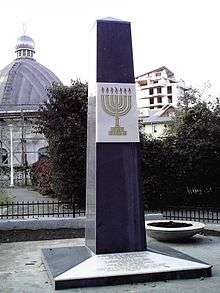
 Victims of Communism Memorial
Victims of Communism Memorial
Twin towns/sister cities
Iași is twinned with:
|
People
References and sources
- References
- "1000 lei 1998 – 80th anniversary of the Great Union of 1918". Romanian Coins.org. Retrieved 24 September 2016.
- "Iași, the cultural city" (in Romanian). Archived from the original on 2 August 2012. Retrieved 24 September 2016.
- "About Iaşi" (in Romanian). La Iaşi. 2002. Retrieved 24 September 2016.
- "Romanian Cities" (in Romanian). Tarom. Archived from the original on 2011-03-05.
- "Results of the 2016 local elections". Central Electoral Bureau. Retrieved 3 April 2020.
- "Population at 20 October 2011" (in Romanian). INSSE. 5 July 2013. Retrieved 4 May 2015.
- "Population on 1 January by age groups and sex - functional urban areas". Eurostat. Retrieved 20 May 2020.
- JASSY at jewishvirtuallibrary.org
- Edith Saurer; Margareth Lanzinger; Elisabeth Frysak (2006). Women's Movements: Networks and Debates in Post-communist Countries in the 19th and 20th Centuries. Böhlau Verlag Köln Weimar. pp. 443–. ISBN 978-3-412-32205-2.
- "Populaţia României pe localitati la 1 ianuarie 2016" (in Romanian). INSSE. 6 June 2016. Archived from the original on 2017-10-27. Retrieved 27 October 2017.
- http://www.festivaprods.com. "GEBA 2017 -Tourism". www.feaa.uaic.ro.
- About Iași City Archived 2011-07-15 at the Wayback Machine
- Iaşi desemnat "Capitală istorică", iar Alba Iulia "Capitală a Marii Uniri"
- "The Economy of a Regional Metropolis. Case-study: Iași, Romania". Transylvanian Review of Administrative Sciences. Retrieved 2012-02-08.
- ionut@xtra-net.ro. "Study in Romanian - Learn & Live Freely". www.study-in-romania.ro. Archived from the original on 2015-06-11. Retrieved 2015-07-19.
- Metropolitan Area Iași (in Romanian)
- "Romanian Pilgrims Flock to Saint's Shrine".
- The beginnings of Iași (in Romanian)
- Ovid (1893) [c. 8 a.d.]. Sidney George Owen (ed.). Ovid: Tristia Book III (2nd, rev. ed.). Oxford: Clarendon Press. p. 60.
- Museum Documentation Center Croatia, A Tractate on the Roman Milestone Discovered near Osijek Archived 2004-11-07 at the Wayback Machine
- Grässe, J. G. Th. (1909) [1861]. "Jassium". Orbis latinus; oder, Verzeichnis der wichtigsten lateinischen Orts- und Ländernamen (in German) (2nd ed.). Berlin: Schmidt. OCLC 1301238 – via Columbia University.
- Orașul Iași: monografie istorică și socială (in Romanian)
- Alexandru I. Gonța, Românii și hoarda de aur, Editura Demiurg, Iași, 2010, p. 102
- C.C. Giurescu, Târguri sau orașe și cetăti moldovene, București, 1967, p.242-245
- Gh. Ghibănescu, Originile Iașilor, în "Arhiva", Iași,1904, p.42-46
- A.P. Horvath, Pechenegs, Cumans, Iașians, Hereditas, Budapest, 1989, p. 64
- C. Cihodaru, G. Platon, Istoria orașului Iași, Editura Junimea, 1980, pp 30–50
- Dan Gh. Teodor, Creștinismul la est de Carpați, Editura Mitopoliei Moldovei și Bucovinei, Iași, 1984, p.91,93,136
- "YIVO - Iaşi". www.yivoencyclopedia.org.
- Great Synagogue of Iași at wmf.org
- Jewishgen
The Iași Pogrom Archived 2012-05-18 at the Wayback Machine at Radio Romania International
Iași Pogrom quotes 13,266 or 14,850 Jews killed. - The last day of the war in Iași (in Romanian)
- General View-The historical and architectural Iași (in Romanian)
- http://www.humangeographies.org.ro/articles/51/5_1_11_9_paftala.pdf
- "The Spatial Evolution of Iași City: Tradition and Trends" by O. Stoleriu and C. Stoleriu
- "Microsoft Word - 6 urban geology and impact of geohazards.doc" (PDF). Archived from the original (PDF) on 2015-05-08. Retrieved 2013-03-26.
- Studiu comparativ de caz despre industria ieșeană (in Romanian)
- Martiniuc, C (1959). "Harta geomorfologică a orașului Iași". Analele Științifice ale Universității "Al. I. Cuza" din Iași (serie nouă), secțiunea II (Științe naturale). 5: 183–190.
- "World Weather Information Service – Iasi". World Meteorological Organization. Archived from the original on July 25, 2017. Retrieved July 25, 2017.
- "CLIMAT summary for 15090: Iasi (Romania) – Section 2: Monthly Normals". CLIMAT monthly weather summaries. Ogimet. Retrieved July 25, 2017.
- "AIR TEMPERATURE (monthly and yearly absolute maximum and absolute minimum)" (PDF). Romanian Statistical Yearbook: Geography, Meteorology, and Environment. Romanian National Statistic Institute. 2007. Retrieved February 10, 2016.
- "Iași Climate Normals 1961–1990". National Oceanic and Atmospheric Administration. Retrieved March 21, 2015.
- "Klimatafel von Iasi (Jassy), Moldau (Bessarabien) / Rumänien" (PDF). Baseline climate means (1961–1990) from stations all over the world (in German). Deutscher Wetterdienst. Retrieved November 23, 2016.
- St. Paraskeve Pilgrimage Centre Archived 2010-09-29 at the Wayback Machine
- Church of the Three Hierarchs Overview at mydestination.com
- "::Turism in orasul Iasi : Churches & monasteries". www.turism-iasi.ro.
- "Iasul istoric – Pelerinaj la Sfânta, în Iaşii de odinioară". curierul-iasi.ro.
- "::Turism in orasul Iasi : It all started at Iasi". www.turism-iasi.ro.
- Pettersen, L. & Baker, M. . Romania. Lonely Planet Travel Guide. p. 262.
- AGERPRES. "DESTINATION/ROMANIA: Iasi - the county of centuries-old trees". www.agerpres.ro.
- [Universitatea Al.I.Cuza Iași Ed. Litera, București 1971, pag.9–10](in Romanian)
- "Chambers's encyclopaedia; a dictionary of universal knowledge for the people". London [etc.] : W. and R. Chambers. 8 January 1860 – via Internet Archive.
- Encyclopædia Britannica Eleventh Edition
- Great Britain. Admiralty (8 January 2018). "A handbook of Roumania". London, H.M. Stationery Off., Frederick Hall [printer] Oxford – via Internet Archive.
- Populatia RPR la 25 ianuarie 1948
- "Ethno-demographic Structure of Romania". The Ethnocultural Diversity Resource Center. Retrieved January 2, 2011.
- "Recensământ 2002". Recensamant.referinte.transindex.ro. Archived from the original on 2009-02-26. Retrieved 2009-06-25.
- "Mother, teacher, nurse. The role of women in society and church according to Hungarian-speaking young Catholics in Romania | Pax Romana ICMICA/MIIC". Web.archive.org. 2007-10-14. Archived from the original on 2007-10-14. Retrieved 2009-07-26.
- HITECH Iași sau cum devine Iașul un magnet pentru investițiile din IT&C Archived 2012-04-11 at the Wayback Machine (in Romanian)
- Numărul de angajaţi ai industriei IT&Outsourcing din Iaşi (in Romanian)
- Fişa localității Municipiului Iași Archived 2016-01-27 at the Wayback Machine (in Romanian)
- Benetton closes all the shops in Romania, but maintains the production facility in Iasi (in Romanian)
- "Bucharest International Wine Contest - Moldavian Wines". www.vinromania.ro. Archived from the original on 2016-01-02. Retrieved 2016-06-02.
- Iasi-Cotnari vineyards Archived 2016-06-30 at the Wayback Machine
- Surprizele din topul firmelor ieşene (in Romanian)
- Top angajatori (in Romanian)
- Iasi, Ziarul de. "FILE DE ISTORIE 155 de ani de la înfiinţarea în Iași a primei Pinacoteci din România". www.ziaruldeiasi.ro.
- Complexul Muzeal National Moldova Iași-Raport de activitate (pg.810) Archived 2015-11-24 at the Wayback Machine (in Romanian)
- About UPA Archived 2015-01-18 at Archive.today (in Romanian)
- "Rețeaua unităților de învățământ preuniversitar". September 2016. Archived from the original on 2017-03-31. Retrieved 2017-03-31.
- "Iași Science Festival – Studii de caz – ABplus Events". www.abplus.ro. Retrieved 2015-11-23.
- European Capitals and Cities of Sport List Archived 2012-04-10 at the Wayback Machine at aces-europa.eu
- About CTP Iași (in Romanian)
- Tot mai puțini ieșeni merg cu RATP-ul (in Romanian)
- Aeroportul Iasi doboara un nou record propriu (in Romanian)
- St. Spiridon Hospital History Archived 2008-12-12 at the Wayback Machine (in Romanian)
- "Iaşul este al doilea cel mai poluat oraş din România. Nu se pot amenaja noi spaţii verzi, dar se cheltuie bani pe studii de calitate a aerului", Romania Curata, retrieved 13 May 2016
- "Comisia Europeană lansează un infringement împotriva României pentru că nu îşi protejează cetăţenii de poluare".
- "Orașe înfrățite (Twin cities of Minsk) [via WaybackMachine.com]" (in Romanian). Primăria Municipiului Chișinău. Archived from the original on 3 September 2012. Retrieved 2013-07-21.
- "Netanya – Twin Cities". Netanya Municipality. Archived from the original on 2013-02-01. Retrieved 2013-08-01.
- Sources

- National Institute of Statistics: http://www.insse.ro
